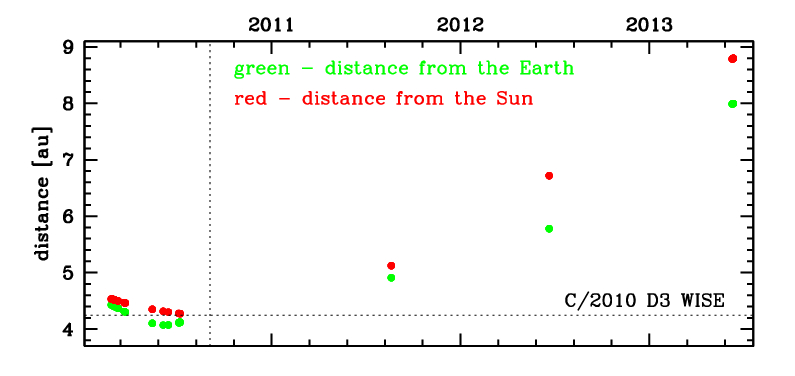C/2010 D3 WISE
more info
C/2010 D3 was discovered in images from the Wide-field Infrared Survey Explorer (WISE) satellite on 26 February 2010.
This comet made its closest approach to the Earth on 7 June 2010 (4.070 au), about 3 months before perihelion passage (see figure).
Solution given here is based on data spanning over 3.3 yr in a range of heliocentric distances: 4.54 au – 4.248 au (perihelion) – 8.80 au.
This Oort spike comet suffers small planetary perturbations during its passage through the planetary system that lead to a more tight future orbit (see future barycentric orbit).
See also Królikowska 2014 and Królikowska and Dybczyński 2017.
This comet made its closest approach to the Earth on 7 June 2010 (4.070 au), about 3 months before perihelion passage (see figure).
Solution given here is based on data spanning over 3.3 yr in a range of heliocentric distances: 4.54 au – 4.248 au (perihelion) – 8.80 au.
This Oort spike comet suffers small planetary perturbations during its passage through the planetary system that lead to a more tight future orbit (see future barycentric orbit).
See also Królikowska 2014 and Królikowska and Dybczyński 2017.
| solution description | ||
|---|---|---|
| number of observations | 97 | |
| data interval | 2010 02 24 – 2013 06 11 | |
| data type | perihelion within the observation arc (FULL) | |
| data arc selection | entire data set (STD) | |
| range of heliocentric distances | 4.54 au – 4.25 au (perihelion) – 8.8 au | |
| detectability of NG effects in the comet's motion | NG effects not determinable | |
| type of model of motion | GR - gravitational orbit | |
| data weighting | YES | |
| number of residuals | 187 | |
| RMS [arcseconds] | 0.52 | |
| orbit quality class | 1a | |
| previous orbit statistics, both Galactic and stellar perturbations were taken into account | ||
|---|---|---|
| no. of returning VCs in the swarm | 4987 | * |
| no. of escaping VCs in the swarm | 14 | |
| no. of hyperbolas among escaping VCs in the swarm | 0 | |
| previous reciprocal semi-major axis [10-6 au-1] | 17.92 – 19.39 – 20.92 | R |
| previous perihelion distance [au] | 630 – 770 – 880 | R |
| previous aphelion distance [103 au] | 94.7 – 102 – 111 | R |
| time interval to previous perihelion [Myr] | 10 – 11 – 13 | R |
| percentage of VCs with qprev > 20 | 100 | |
| previous_g orbit statistics, here only the Galactic tide has been included | ||
|---|---|---|
| no. of returning VCs in the swarm | 4997 | * |
| no. of escaping VCs in the swarm | 4 | |
| no. of hyperbolas among escaping VCs in the swarm | 0 | |
| previous reciprocal semi-major axis [10-6 au-1] | 18.57 – 20.07 – 21.64 | R |
| previous perihelion distance [au] | 12 – 23 – 44 | R |
| previous aphelion distance [103 au] | 92.4 – 99.6 – 108 | R |
| time interval to previous perihelion [Myr] | 9.8 – 11 – 12 | R |
| percentage of VCs with qprev < 10 | 6 | |
| percentage of VCs with 10 < qprev < 20 | 33 | |
| percentage of VCs with qprev > 20 | 61 | |
